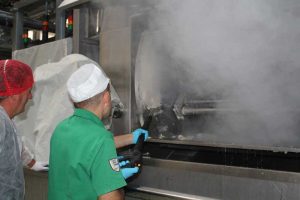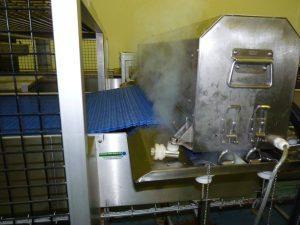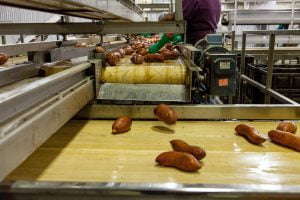Belt cleaners are an essential component of conveyor systems in various industries, including mining, manufacturing and agriculture. Their primary function is to remove material carryback from the conveyor belt, ensuring that the belt remains clean and free from debris. Material carryback can cause a range of issues, including belt mistracking, increased wear and tear on the conveyor system and potential safety hazards.
By effectively removing carryback, belt cleaners help to maintain the efficiency and safety of the conveyor system. In addition to preventing material build-up on the belt, belt cleaners also play a crucial role in maintaining the integrity of the conveyed material. Without proper cleaning, material carryback can contaminate the conveyed product, leading to quality control issues and potential product wastage.
Furthermore, the accumulation of material on the belt can increase the risk of spillage and dust emissions, which can have environmental implications and pose health and safety risks for workers. Therefore, investing in high-quality belt cleaners is essential for ensuring the smooth operation of conveyor systems and protecting the integrity of conveyed materials.
Summary
- Belt cleaners are crucial for maintaining conveyor system efficiency and safety
- Factors to consider when choosing a belt cleaner include belt type, material handled, and environmental conditions
- Different types of belt cleaners include primary, secondary, and specialty cleaners
- Proper installation and maintenance of belt cleaners are essential for optimal performance
- Choosing the right belt cleaner for specific applications can improve conveyor system efficiency and reduce maintenance costs
- Belt cleaners impact conveyor system efficiency and safety by reducing spillage and material buildup
- Tips for selecting the best belt cleaner include evaluating performance, durability, and compatibility with the conveyor system
Factors to Consider When Choosing a Belt Cleaner
Material Considerations
One of the key considerations is the type of material being conveyed, as different materials may require different cleaning mechanisms to effectively remove carryback.
Environmental and System Factors
The operating environment, including factors such as temperature, humidity, and potential exposure to corrosive substances, should be taken into account when choosing a belt cleaner. The design and construction of the conveyor system itself also play a significant role in determining the most suitable type of belt cleaner. Factors such as belt speed, belt width, and pulley diameter can impact the performance and effectiveness of a belt cleaner.
Maintenance and Compatibility
Furthermore, it is essential to consider the maintenance requirements of the cleaner, as well as its compatibility with existing conveyor components.
Optimal Performance and Longevity
Ultimately, selecting the right belt cleaner involves a thorough assessment of the specific requirements and operating conditions of the conveyor system to ensure optimal performance and longevity.
Different Types of Belt Cleaners Available

There are several types of belt cleaners available on the market, each designed to address specific cleaning challenges and operating conditions. One common type of belt cleaner is the primary cleaner, which is typically installed at the head pulley to remove the bulk of the carryback from the belt. Secondary cleaners are often used in conjunction with primary cleaners to provide additional cleaning and ensure that any remaining carryback is effectively removed.
Tertiary cleaners may also be employed in some applications to further enhance cleaning efficiency. In addition to primary, secondary, and tertiary cleaners, there are also specialty cleaners designed for specific applications or challenging operating conditions. For example, in environments where material buildup is prone to freezing, heated belt cleaners can be used to prevent ice formation and maintain effective cleaning performance.
Similarly, in applications where space is limited or access for maintenance is restricted, compact or low-maintenance belt cleaners may be preferred. By understanding the different types of belt cleaners available and their respective capabilities, conveyor system operators can make informed decisions when selecting the most suitable cleaner for their specific requirements.
The Importance of Proper Installation and Maintenance
Proper installation and regular maintenance are essential for ensuring the effective performance and longevity of belt cleaners in conveyor systems. During installation, it is crucial to follow manufacturer guidelines and recommendations to ensure that the cleaner is correctly positioned and aligned with the conveyor belt. Proper tensioning of the cleaner blade or blades is also critical to achieve optimal cleaning performance without causing excessive wear on the belt.
Regular maintenance of belt cleaners is equally important to prevent premature wear and ensure consistent cleaning efficiency. This includes routine inspection of the cleaner components for signs of wear or damage, as well as adjusting tension and replacing worn blades as necessary. Additionally, cleaning and lubricating moving parts can help to prolong the life of the cleaner and maintain its effectiveness over time.
By prioritising proper installation and ongoing maintenance, conveyor system operators can maximise the performance and service life of their belt cleaners.
Choosing the Right Belt Cleaner for Specific Applications
Selecting the right belt cleaner for a specific application requires careful consideration of various factors to ensure that the cleaner is capable of effectively addressing the unique cleaning challenges and operating conditions. For example, in applications where sticky or tacky materials are being conveyed, a belt cleaner with a non-stick blade material or a secondary cleaning mechanism may be necessary to prevent material buildup on the belt. Similarly, in high-temperature environments, it is essential to choose a cleaner that can withstand elevated temperatures without compromising its cleaning performance.
The size and configuration of the conveyor system also influence the selection of a suitable belt cleaner. For wide belts or high-speed conveyors, a robust and durable cleaner with a large cleaning surface may be required to effectively remove carryback. Conversely, in applications with limited space or restricted access for maintenance, a compact and low-maintenance cleaner design may be more practical.
By carefully evaluating the specific requirements and operating conditions of the conveyor system, operators can choose a belt cleaner that is tailored to their needs and capable of delivering reliable cleaning performance.
The Impact of Belt Cleaners on Conveyor System Efficiency and Safety

Enhancing Efficiency and Reducing Downtime
The presence of effective belt cleaners in a conveyor system has a significant impact on both its efficiency and safety. By removing material carryback from the belt, cleaners help to prevent buildup on idlers, pulleys, and other conveyor components, reducing the risk of belt mistracking and potential damage to the system. This not only minimises downtime for maintenance and repairs but also extends the service life of conveyor components, contributing to overall system efficiency.
Creating a Safer Working Environment
Furthermore, by reducing material spillage and dust emissions, belt cleaners contribute to a safer working environment for personnel operating or working near the conveyor system. Material spillage can create slip hazards, while dust emissions pose respiratory health risks for workers. Effective cleaning helps to mitigate these hazards, promoting a safer workplace and reducing the potential for accidents or injuries.
A Sound Investment for Conveyor System Operators
Therefore, investing in high-quality belt cleaners is not only beneficial for maintaining conveyor system efficiency but also for safeguarding the well-being of personnel working in proximity to the system.
Tips for Evaluating and Selecting the Best Belt Cleaner for Your Conveyor System
When evaluating and selecting a belt cleaner for a conveyor system, it is essential to consider several key factors to ensure that the chosen cleaner meets the specific requirements and operating conditions. Conducting a thorough assessment of the material being conveyed, as well as the environmental factors and operating parameters, will help to identify the most suitable type of cleaner for the application. Additionally, consulting with experienced professionals or manufacturers can provide valuable insights into selecting a cleaner that aligns with the unique needs of the conveyor system.
Furthermore, it is important to consider not only the initial cost but also the long-term value and performance of the chosen belt cleaner. Investing in a high-quality cleaner that offers durability, reliability, and low maintenance requirements can result in long-term cost savings and operational efficiency. Finally, regular monitoring and evaluation of the cleaner’s performance will help to identify any potential issues or areas for improvement, allowing for adjustments or upgrades as necessary to maintain optimal cleaning efficiency.
In conclusion, belt cleaners play a crucial role in maintaining the efficiency and safety of conveyor systems across various industries. By effectively removing material carryback from conveyor belts, cleaners help to prevent issues such as belt mistracking, increased wear on system components, and potential safety hazards. When choosing a belt cleaner, it is important to consider factors such as material type, operating environment, system design, installation, maintenance requirements, and specific application needs.
By selecting a suitable belt cleaner tailored to their requirements, operators can ensure optimal cleaning performance and contribute to overall system efficiency and safety.
FAQs
What is a belt cleaner for a conveyor system?
A belt cleaner is a device used to remove material adhering to the carrying surface of a conveyor belt. It is essential for maintaining the efficiency and longevity of the conveyor system.
Why is it important to choose the right belt cleaner for your conveyor system?
Choosing the right belt cleaner is important because it directly impacts the efficiency, productivity, and maintenance costs of the conveyor system. The right belt cleaner will effectively remove material buildup without causing damage to the belt.
What factors should be considered when choosing a belt cleaner?
When choosing a belt cleaner, factors such as the type of material being conveyed, belt speed, belt width, and the specific requirements of the application should be taken into consideration. Additionally, the operating environment and the type of conveyor system will also influence the choice of belt cleaner.
What are the different types of belt cleaners available?
There are several types of belt cleaners available, including primary cleaners, secondary cleaners, and specialty cleaners. Primary cleaners are positioned on the head pulley and are the first line of defense against material buildup. Secondary cleaners are positioned further along the belt and provide additional cleaning. Specialty cleaners are designed for specific applications or challenging materials.
How do I know if a belt cleaner is suitable for my conveyor system?
To determine if a belt cleaner is suitable for your conveyor system, it is important to consider the manufacturer’s recommendations, as well as conducting a thorough assessment of the specific requirements and operating conditions of the conveyor system. Additionally, consulting with a professional in the field can provide valuable insights.










